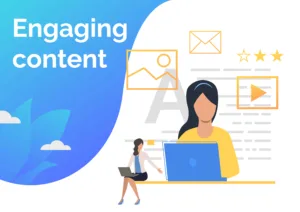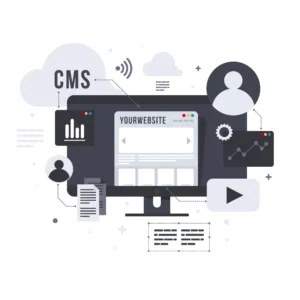Content generation is a crucial part in content marketing as it has become an important strategy to any marketing plan in the current digital era. The significance of content marketing is demonstrated by the fact that organisations that prioritise it achieve conversion rates that are six times greater than those of their rivals who don’t.
Firstly content marketing involves more than just producing content; it also entails producing content that is tailored to the demands of your target audience and optimised for search engines. We’ll go over the fundamentals of content creation and optimisation in this article, as well as how to produce material that attracts visitors and turns leads into customers
1. Content creation

Generating content is the process of producing worthwhile and pertinent material that draws in and engages your target audience. So the following actions are part of content generation:
a. Determine Your Goal Audience
Finding your target audience is the first stage in content creation. The individuals who are most likely to buy your good or service should be your target market. You can use resources like consumer surveys, social media analytics, and Google Analytics to pinpoint your target market.
b. Establish Your Content Goals
Establishing your content goals comes after determining your target audience. Your overarching business objectives and your content goals should be compatible. For instance, if one of your business goals is to raise brand awareness, one of your content goals might be to boost website traffic and social network followers.
c. Lay Out Your Content Strategy
You must develop a content strategy after identifying your target audience and deciding on your content objectives. The sorts of material you’ll produce, the subjects you’ll cover, and the channels you’ll use to distribute your content should all be part of your content strategy.
d. Develop Content Thoughts
You can use resources like Google Trends, BuzzSumo, and SEMrush to come up with article ideas. You can use these tools to find out what topics and phrases are most searched for in your sector.
e. Produce Content
You need to generate your content after coming up with content ideas. Make sure your material is useful, timely, and interesting when writing it. Additionally, your material needs to be search engine optimised and should contain terms that your intended audience uses to search.
2. Content Optimization

The practise of making your material more appealing and noticeable to your target audience is known as content optimisation. The following steps are included in content optimisation:
a. Carry out a keyword search
Keyword research is the initial stage in content optimisation. Finding the search terms used by your target market is known as keyword research. To do keyword research, you can make use of programmes like Google Keyword Planner, SEMrush, and Ahrefs.
b. Boost Your Content
Following keyword research, content optimisation is required. In order to accomplish this, you must incorporate the keywords into your content in a way that feels natural. In order to include your goal keywords, you should also optimise your title tag, meta description, and URL.
c. Employ visuals
Your material can become more engaging and shared by adding visuals. As a result your material should be visually engaging by using infographics, videos, and images to break it up.
d. Be mobile-friendly
Mobile devices account for more than 50% of all internet traffic. Therefore, it’s crucial to make your material mobile-friendly. Use a responsive design, shorten load times, and make sure your information is readable on smaller screens to achieve this.
e. Market Your Content
The last step is to market your material. Through influencer outreach, email marketing, and social media, you may advertise your content. You may raise the profile of your content and increase traffic to your website by advertising it.
Advantages of Content Generation and Optimization

Businesses that want to thrive in the current digital world should consider the various benefits of content generation and optimisation. The following are some benefits of content creation and optimisation:
1. Increases Visibility by doing content generation
By making your material more visible to search engines, you can reach a larger audience. This might enhance internet traffic and brand awareness for your company.
2. Develops Trust
By producing worthwhile and pertinent content, you develop trust with your target audience. This can help you position your company as an expert in your field and increase the likelihood that customers will work with you.
3. Enhances User Experience
You may make your website’s visitors’ experiences better by producing high-quality content that speaks to the demands of your target market. Increased engagement and fewer bounce rates may result from this.
4. Content generation can produce Leads
By producing content that is optimised for lead generation, you may increase the number of leads coming into your company. Your consumer base can expand and your revenue can rise as a result.
5. More Website Traffic
Companies can increase website traffic by producing high-quality, optimised content. This is possible through search engine optimisation (SEO), which entails including keywords and other optimisation strategies in your material to increase its exposure in search engine results pages (SERPs).
6. Better Search Engine ranks
You can raise your website’s search engine ranks by optimising your content for search engines. This can make it so that your website ranks higher in search results, increasing the likelihood that users will find your company.
7. Improved User Experience
Businesses may give their website users a better experience by producing interesting and educational content. Longer visit times, fewer bounce rates, and eventually higher conversions can result from this
The main reasons for doing content generation and optimization include
Their are lot of reasons for doing content generation. Here are some points written in below segment:
1. To draw in and maintain interested customers
Businesses can draw interested customers to their websites by producing high-quality material that is useful, educational, and pertinent to their target demographic.
2. To raise your website’s search engine rankings
By making your material more search engine-friendly, you can raise the likelihood that potential clients will find your company online.
3. To position your company as a thought leader in its field
By producing insightful and educational material, companies may position themselves as thought leaders in their field, gaining credibility and trust from potential clients.
4. To raise brand awareness by making content generation planings
By developing and disseminating high-quality content, businesses can raise brand awareness, increasing the likelihood that prospective buyers will remember their brand and take them into consideration as a viable option.
5. To create leads and boost conversions
Businesses may generate leads and boost conversions by producing content that is tailored to their target market’s demands and search engine-optimized. As a result, more sales and money are made.
Types of Content Generation and Optimization

To enhance their online presence and draw in more customers, firms can use a variety of content development and optimisation techniques. Among the most popular forms of content creation and optimisation are:
1. Blogging
A well-liked strategy for businesses to produce and distribute informative information to their audience is blogging. Blog postings can discuss a variety of subjects, from product reviews and how-to instructions to industry news and trends.
2. Infographics
Infographics are a visually appealing approach to display intricate data and information in a style that is simple to understand. On a range of subjects, they can be used to instruct and inform your audience.
3. Use videos in content generation
Businesses are using videos to disseminate company news, provide instructions, and promote their goods and services. Because video content is growing in popularity.
4. Whitepapers and E-books
These longer-form content items offer comprehensive information on a particular subject. They are frequently utilised to build a company’s reputation as a thought leader in their sector and produce leads.
5. Social Media Posts
Social media offers businesses a strong platform to interact with their customers and provide content. Their posts may contain a range of material kinds, including photographs, videos, and connections to other articles or webpages.
6. Webinars for content generation
Participants in webinars receive instructive or interesting content through live or recorded internet events. So they are frequently utilised to generate leads and position a company as an authority in their field.
Businesses may produce a wide range of content that appeals to their target audience and attracts visitors to their website by utilising a variety of content generation and optimisation tactics.
How to find topic for content generation
It might be difficult to come up with subjects for content development, but there are a number of methods that organisations can utilise to generate fresh concepts. Here are some ideas for things to research when creating content:
1. Research your audience for content generation
Creating content that appeals to your target market requires an understanding of who they are. You can learn more about your target market’s problems, interests, and concerns about your goods and services by conducting market research and getting feedback from your current clients.
2. Examine industry trends
Staying current with industry news and trends will help you pinpoint subjects that are currently pertinent and appealing to your target audience. This can involve participating at industry events, subscribing to newsletters, and following relevant social media accounts.
4. Use keyword research tools for content generation
Using keyword research tools like Google Keyword Planner will help you find words and phrases that people in your target market regularly look for. This might help you come up with topics that will likely drive visitors to your website.
5. Take a look at your rivals
Examining the material that your rivals make might help you come up with ideas for subjects that have a history of being well-received by your intended audience. To stand out and provide your audience something new, it’s crucial to add your own distinctive touch to the content.
6. Repurpose current content
Lastly by repurposing current content, such as transforming a blog post into a video or an infographic from a whitepaper, you may both come up with fresh content ideas. Because make the most of the information you’ve already created.
Combining these strategies will enable businesses to produce a consistent stream of intriguing, fresh content that appeals to their target market and increases website traffic.
Click here to check our service and contact us for boosting your business or website.
Address: 2nd floor, Soni Pariwar, Street Number 11, Shiv Nagar, Hisar, Haryana 125001
Working days: Monday – Saturday
phone: +91-8222887771 / 7027675737
Email: helpdesk@theiklone.com
Please check our latest posts as well.
- Bike Tyre LED Light Rim Valve Cap with Motion Sensor
- Multicolor Amazon T-Shirt for Men (Pack of 5) – A Steal Deal on Amazon!
- Fire TV Stick: Unlocking Limitless Entertainment
- Affiliate Marketing for Beginners: A Step-by-Step Guide 2023
- The Power of Video Marketing: How to Promote Your Business on YouTube
